miR-4521-FAM129A axial regulation on ccRCC progression through TIMP-1/MMP2/MMP9 and MDM2/p53/Bcl2/Bax pathways
- PMID: 31016032
- PMCID: PMC6465337
- DOI: 10.1038/s41420-019-0167-5
miR-4521-FAM129A axial regulation on ccRCC progression through TIMP-1/MMP2/MMP9 and MDM2/p53/Bcl2/Bax pathways
Abstract
Clear cell renal cell carcinoma (ccRCC) is the most aggressive RCC subtype with high metastasis, chemotherapy and radiotherapy resistance, and poor prognosis. This study attempted to establish the deregulations of miR-4521 and FAM129A together with their correlation to and mechanism of regulation of ccRCC development and progression. FAM129A acted as tumor promotor and miR-4521 acted as a suppressor in ccRCC. As measured in surgical tumorous tissues from ccRCC patients, FAM129A overexpression and miR-4521 deficiency together contributed to ccRCC progression by promoting advances in patients' TNM stage and Fuhrman grade. Both the FAM129A knockdown and miR-4521 overexpression could reduce the in vitro migration and invasion abilities of renal cancer cells 786-O and ACHN, through the TIMP-1/MMP2/MMP9 pathway and could decrease their proliferation by promoting their apoptosis through the MDM2/p53/Bcl2/Bax pathway. By directly targeting the 3'-UTR domain of FAM129A, miR-4521 was negatively correlated with FAM129A/FAM129A levels in ccRCC progression and renal cancer cell malignancies. This work establishes the miR-4521-FAM129A axial regulation mechanism in ccRCC. Micro-4521 deficiency leads to FAM129A/FAM129A upregulation, which synergistically enhances the migration and invasion of renal cancer cells due to the induced decrease of TIMP-1 and increases of MMP2 and MMP9, and increases their growth through escaping apoptosis by suppressing p53 by way of upregulation of induced MDM2. The current work provides new clues to assist fundamental research into the diagnosis and treatment of ccRCC.
Conflict of interest statement
The authors declare that they have no conflicts of interest.This study was conducted in accordance with the ethical standards of the national ethics committee with written informed consent from each participant.
Figures

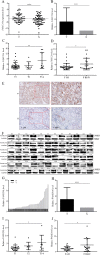

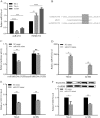
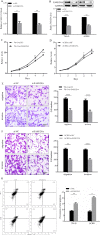
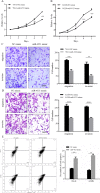
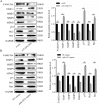
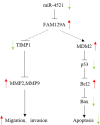
Similar articles
-
MiR-4521 plays a tumor repressive role in growth and metastasis of hepatocarcinoma cells by suppressing phosphorylation of FAK/AKT pathway via targeting FAM129A.J Adv Res. 2021 May 12;36:147-161. doi: 10.1016/j.jare.2021.05.003. eCollection 2022 Feb. J Adv Res. 2021. PMID: 35127170 Free PMC article.
-
miR-429-CRKL axis regulates clear cell renal cell carcinoma malignant progression through SOS1/MEK/ERK/MMP2/MMP9 pathway.Biomed Pharmacother. 2020 Jul;127:110215. doi: 10.1016/j.biopha.2020.110215. Epub 2020 May 12. Biomed Pharmacother. 2020. PMID: 32413671
-
FAM129A promotes invasion and proliferation by activating FAK signaling pathway in non-small cell lung cancer.Int J Clin Exp Pathol. 2019 Mar 1;12(3):893-900. eCollection 2019. Int J Clin Exp Pathol. 2019. PMID: 31933898 Free PMC article.
-
MicroRNA-497 suppresses renal cell carcinoma by targeting VEGFR-2 in ACHN cells.Biosci Rep. 2017 May 19;37(3):BSR20170270. doi: 10.1042/BSR20170270. Print 2017 Jun 30. Biosci Rep. 2017. Retraction in: Biosci Rep. 2025 Aug 18;45(8):BSR20170270_RET. doi: 10.1042/BSR20170270_RET. PMID: 28465356 Free PMC article. Retracted.
-
GRIM-19 deficiency promotes clear cell renal cell carcinoma progression and is associated with high TNM stage and Fuhrman grade.Oncol Lett. 2020 Jun;19(6):4115-4121. doi: 10.3892/ol.2020.11498. Epub 2020 Mar 31. Oncol Lett. 2020. PMID: 32382350 Free PMC article.
Cited by
-
STAT3 Mediated miR-30a-5p Inhibition Enhances Proliferation and Inhibits Apoptosis in Colorectal Cancer Cells.Int J Mol Sci. 2020 Oct 3;21(19):7315. doi: 10.3390/ijms21197315. Int J Mol Sci. 2020. PMID: 33023006 Free PMC article.
-
Hypoxia downregulated miR-4521 suppresses gastric carcinoma progression through regulation of IGF2 and FOXM1.Mol Cancer. 2021 Jan 6;20(1):9. doi: 10.1186/s12943-020-01295-2. Mol Cancer. 2021. PMID: 33407516 Free PMC article.
-
Prognostic value of microRNA-4521 in non-small cell lung cancer and its regulatory effect on tumor progression.Open Med (Wars). 2021 Aug 11;16(1):1150-1159. doi: 10.1515/med-2021-0312. eCollection 2021. Open Med (Wars). 2021. PMID: 34435140 Free PMC article.
-
Exome-wide association study reveals 7 functional variants associated with ex-vivo drug response in acute myeloid leukemia patients.BMC Med Genomics. 2025 Apr 4;18(1):64. doi: 10.1186/s12920-025-02130-7. BMC Med Genomics. 2025. PMID: 40186177 Free PMC article.
-
Cancer Cell Acid Adaptation Gene Expression Response Is Correlated to Tumor-Specific Tissue Expression Profiles and Patient Survival.Cancers (Basel). 2020 Aug 5;12(8):2183. doi: 10.3390/cancers12082183. Cancers (Basel). 2020. PMID: 32764426 Free PMC article.
References
LinkOut - more resources
Full Text Sources
Research Materials
Miscellaneous

